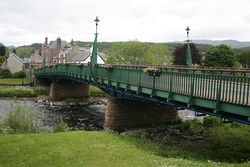Parapet
| Parapet | |
 | |
| Pictures related to Parapet No pictures uploaded (Upload?) | |
Parapets are employed on the road network for two basic purposes. Firstly across bridges to prevent traffic plunging into the water (or road / railway) below, and secondly on roads, generally through hilly ground, where there is a sharp drop below. In the latter instances, parapets have generally given way to Crash Barriers in the last half century. Parapets can be constructed from a range of materials, and they are mostly used for either purpose.
Masonry Parapets
Stone Parapets have been employed on Stone Bridges almost from the beginning, thousands of years ago, and were certainly included in most of the oldest stone bridges surviving in Britain and Ireland. The exception is the narrow Packhorse Bridge, where the narrow width of the overall structure, and the wideness of the animals packs conflicted, so parapets were often omitted. Arguably, and notwithstanding the last comment, in the days of horse-drawn transport, the need to have a solid structure to prevent a startled horse falling off a bridge were even more critical than the more controlled motoring age. As a rule, stone bridge parapets were constructed as an integral part of the bridge structure, and whilst many have been repaired over the years, this can be used as evidence for the resilience of the basic design.
It was an easy leap from designing bridges with stone parapets to building them alongside roads where there was a sharp drop. They were often built in conjunction with a Retaining Wall on the uphill side of the road. Indeed, in many cases the parapets themselves are just an extension of a retaining wall holding the road up. They can vary in height from just a few inches - enough to deflect a wayward tyre, like a kerb does, to a metre or more in a few cases.
Since the Victorian era, Bridges and therefore Parapets have been increasingly built out of Brick and then Concrete. Whilst Stone Parapets have proven their worth for centuries, few stand little chance when confronted with an out of control 44 Tonne Artic, and so even reinforced concrete parapets have fallen from favour. It has not been necessary to undertake a wholesale upgrade of old parapets, but reinforcements have been added when necessary, and some modern bridges designed with masonry parapets to be 'in keeping' with their surroundings are constructed around a substantial steel structure to minimise the risk. In other situations, Crash Barriers have been installed on the inside of the barrier for the same purpose.
Whilst the vast majority of masonry parapets are solid masonry, albeit often with some form of design in relief, the Victorians in particular were keen on the colonnade type where stone pillars supported a continuous line of coping stones. This led to the later pierced concrete parapets often used in the early era of Concrete bridges, although by then a reduction in material and mass was more important than any aesthetic qualities.
Iron Parapets
It was probably in the Victorian era when the use of decorative metal railings on bridge parapets became common practice. Irrespective of the structure below, not new bridge was complete without a highly decorative set of wrought iron railings on either side to proclaim the prowess of the corporation or individual who had funded the new bridge. Even smaller, less glamorous structures would be embellished with some off the shelf spiked railings between decorative bollards.
Later bridges featured some simpler designs, perhaps diagonal bars criss-crossed to suggest a truss or just horizontal rails between stone pillars. However, they all served the same purpose, and for the transport of their day were more than adequate. It should be noted, however, that few iron parapets were used on hill roads, and then it was normally just standard railings.
The most noticeable other form of iron parapet was that used on railway bridges, which have always seemed to have been fitted with solid parapets. As such, it is common to find substantial sheets of black painted iron plate above the span, between masonry pillars. These often rise to 5 feet or more in height, preventing trainspotters from easily looking over, although it is unlikely this is the reason for this design!
Modern Parapets
Since the beginning of the motorway era, one type of parapet has predominated over all others. That is the Metal fences or railings, often constructed from Stainless Steel, which run between the fences on either side of the span. This means that bridges are designed with the minimum of superstructure, and factory produced sections are then bolted in to place, either direct onto pre-cast holes in the concrete deck, or to brackets mounted on the steel girders below.
The uprights of these parapets are often triangular in profile, tapering to the top, and vertical on the roadside, so as to provide maximum strength against wayward vehicles. Various numbers of horizontal rails are used, with an equal variation in the spacing of the verticals. Often the railings are also fitted with a mesh to prevent small people squeezing through, and they prove equally useful, when a bridge crosses another road or railway, for retaining stones or twigs on the deck.
On some of the more substantial bridges, particularly the high level estuary crossings around the coast, the parapets are effectively security fencing rising to 6 foot or more. Sadly this design is predominantly to deter suicides, but has a range of other benefits in deflecting cross-winds and limiting high altitude bird strikes.


